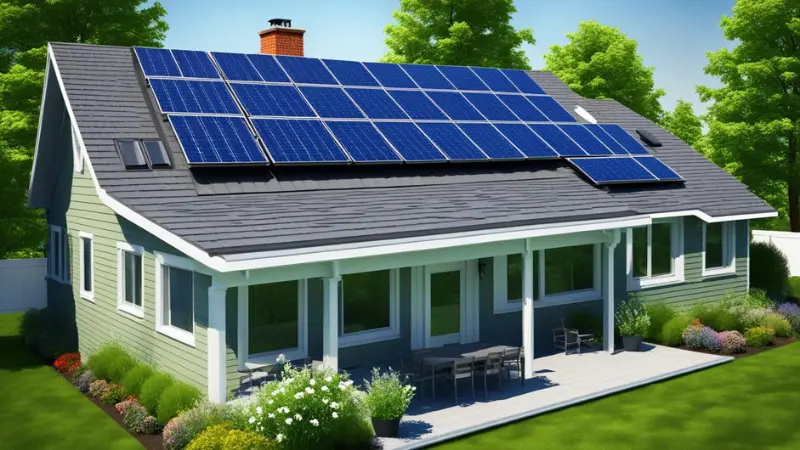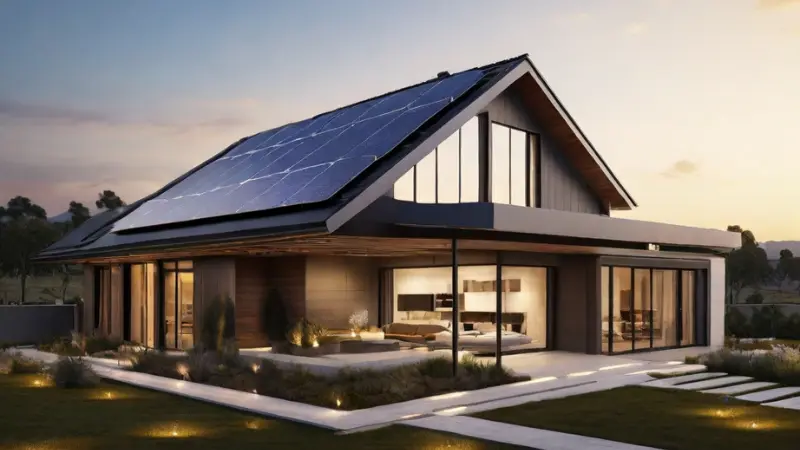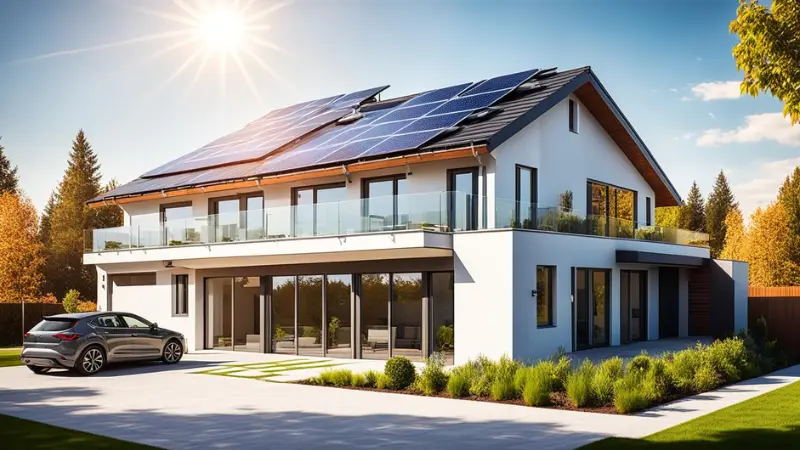Ultimate Guide to Solar Panel Roof Requirements: Essential Tips for Success
Updated: 07 Sep 2024
154
It is an incredible feat, but the record has been broken. In 2022 and again in 2023, the company installed 27 solar photovoltaic systems, which should have a capacity of at least eight gigawatts. This represents a 39% increase over last year. The demand for clean energy is exciting and rising dramatically, particularly for solar roofs. Understanding the general steps and procedures involved when installing solar roofs is more crucial than ever.

At the end of this guide, you will find all the essential facts about installing solar panels on your roof within reach. This tool identifies the best type of solar panel, determines whether the roof suits solar panel installations and determines how to get the right panel arrangements. You’ll also learn about making your solar roof look good and fit right. With its detailed advice, you can turn your roof into a powerful, green energy source.
solar panel roof requirements
Are you a homeowner eager to go green? A solar technology fan? Or you want to lower your carbon footprint. It is the guide you have been searching for. We will explain what strategy you need to apply to get the most significant benefit from the roof with the help of solar panels. Start today, and light up the future with solar energy.
Today, we can start doing what is available and have the technology to help the future with solar energy.
Introduction to Solar Panel Roof Requirements
Roof-mounted solar systems are among the favorites for harnessing the sun’s energy. However, it’s important to know the solar panel roof requirements first. These ensure your solar system works well and efficiently.
Understanding the Importance of Proper Roof Setup
The correct roof setup is critical for solar panel success. Your roof’s orientation and tilt matter, as does its structural integrity. These things affect how well your solar panels can use the sun’s energy. By choosing your panels wisely, you can save more energy and make your system more sustainable.
Benefits of Installing Solar Panels on Your Roof
There are several advantages of installing solar panels, especially on roofs. They save electricity expenses and increase energy independence to some extent, which is also good for the planet. They also said that the value of our homes is likely to increase with the installation of solar panels. This makes them one of the intelligent investment products to consider for the future, helping you save money and protect the environment.
Assessing Your Roof’s Suitability for Solar Panels
First, you have to ensure that your roof is suitable for solar panels, and if it is, proceed with the installation. Consider factors such as the orientation of the roof slope and the existence of shadows or whether they are strong enough to support the installation of the solar system. All these are relevant in determining the usability of your solar panels on your rooftop.
Evaluating Roof Orientation and Tilt
Even the roof placement dramatically affects how much power it can harness using rooftop solar power. Position your roof to face the south if you live in the north or to the north if you’re in the southern region. This way, you’ll make the most of the abundant sunshine in your area.”It is ideal to have the roof tilt between 1/2 and 3/4 inches per foot, while the intermediate roof tilt is between 0 and 1/3rd of an inch per foot. It helps the roof get the most out of the sunlight.
Identifying Potential Shading Issues
Shade can lower the efficiency of your solar panels. Look for anything nearby that could block the sun, like trees or buildings. As with every activity, checking in detail for shade will help you identify areas to place the panels to get the best sunlight.
Checking Structural Integrity and Load-Bearing Capacity
Another factor that “Should be carefully considered” is what we referred to before as the load-bearing capabilities of the roofing structure, which can include the roof’s structural integrity in bearing the weight of solar panels. It is essential to locate solar panels carefully since they are heavy and must installed on a sturdy roof. Get an expert to ensure your roof is strong enough for solar panels.
Looking into these roof details can help you decide if solar panels are right for you. A good check-up can boost your system’s power and success for many years.
Choosing the Right Solar Panel Type
Therefore, decisions when selecting a solar panel for your roof are critical. It determines your system’s performance, efficiency, and expenses associated with these two characteristics. Understanding these crucial factors will help you comprehend each solar panel’s strengths and weaknesses. They also guide you to the most appropriate energy needs and financial capabilities provider. In this research, we will compare monocrystalline, polycrystalline, and thin-film types of solar panels.
Monocrystalline Solar Panels: Advantages and Disadvantages
Monocrystalline panels are best for efficiency, and their structure looks entirely professional. They are formed from a sole silicon crystal, which provides powerful conversion coefficients of approximately 15 to 22. They are also good because they require less roof space but are expensive to purchase and make.
Polycrystalline Solar Panels: Pros and Cons
Polycrystalline sunsheets are relatively cheap. They are less efficient than monocrystalline ones, which are between 13 % and 16 % efficient. They are blue and have a similar shape, which makes them better in terms of looks. Due to these reasons, they are ideal for homeowners who want a unit despite their inferior quality compared to the better ones in the market.
Thin-Film Solar Panels: Flexibility and Efficiency
Thin-film panels are easily transported and flexible for various building materials. Their wide use is due to their ability to be used in a variety of solar projects. Although they may not be as effective as others, with conversion rates varying between 10% and 15%, they are effective in low-light or sunny areas. Their production procedure is also relatively environmentally friendly, making them cheaper than traditional solar LCA technologies.
So, when you select a specific kind of solar panel, do it based on essential criteria such as efficiency, performance, cost, and mere appearance. , knowing its strengths and weaknesses enables one to make good decisions. Therefore, you must consider your energy needs and the energy costs you will incur.
| Solar Panel Type | Efficiency | Performance | Cost |
| Monocrystalline | 15% – 22% | High | High |
| Polycrystalline | 13% – 16% | Moderate | Moderate |
| Thin-Film | 10% – 15% | Good in low-light | Low |
Optimizing Solar Panel Layout and Placement
Getting the most from a solar roof requires thoughtful panel planning. It affects how much energy you get and how long your system lasts.
Determining Optimal Panel Arrangement for Maximum Sunlight Exposure
The right placement of solar panels is key to getting the best sunlight. If your panel is aligned and tilted correctly, its power output will increase. Talking to a solar expert is a good move. They can help you pick the perfect setup for your roof.
Efficient Use of Available Roof Space
It is essential to use every inch of the roof wisely for solar panels. You might set them up in different ways. For some spaces, putting them directly on the roof might be best. It looks good and keeps the roof strong.
Considering Airflow and Maintenance Access
When installing solar panels, it’s smart to consider more than sunlight and space. Good airflow can cool the panels, making them work better. Plus, setting them up for easy cleaning and check-ups helps them last longer.

Aesthetic and Structural Integration of Solar Panels
Since then, people have given more importance to solar energy as homeowners. This means they desire aesthetically functional solar panels that will complement the architecture of the house. And that’s where building-integrated photovoltaics (BIPV) comes in as the next phase in advancement for solar technology. It enables the seamless setup of solar panels in any built-in home design.
Building-Integrated Photovoltaics (BIPV) for Seamless Integration
Building Integrated Photovoltaic Systems combines BIPV with the construction of the building, such as the roof or walls. It makes everything look nice and flow together. It uses space better and gets rid of those big, ugly panels. Homeowners then get to use clean energy without ruining how their house looks.
Proper Anchoring and Weight Distribution
Roofs with solar panels must be strong, anchored well, and spread out to be safe. Good planning and using smart building-integrated photovoltaics (BIPV) keep everything sturdy. BIPV also helps spread the solar system’s weight, making it safer for the roof.
Working on how solar panels look and set up is critical. It will allow homeowners to add solar power to their homes without standing out incorrectly. Instead, it will fit right in and look great while helping the environment.
solar panel roof requirements
If you plan to install solar panels, there is some information that is important for you to discover regarding state and local legislation. These are key for a trouble-free installation process.
Understanding Local Regulations and Building Codes
If you are considering installing solar panels on your property, this article will give you an overview of some of the local regulations you should consider. These cover things like how much weight the roof can handle, safety with electricity, and how the panels look. Determining the rules you need to follow in your area is crucial to ensure the correct installation of your solar panels.
Obtaining Necessary Permits and Approvals
But more often, as a first step, you must apply for a permit and get tenant approval. You may need to show detailed plans, get structural and electrical permits, and get approval from your neighborhood association or preservation board if it’s historical. If you don’t get these permits, you might still need to put solar panels down.
Knowing the solar panel roof requirements and the steps to get the proper permits and approvals is crucial. It ensures a smooth installation that follows all the laws, which is very important for your solar power system to work well for a long time.

Calculating Costs and Potential Savings
Thinking about a solar-powered roof means understanding the money side of things. This part helps you figure out the costs right at the start. It also looks at how much you might save on electricity. Plus, we’ll check out the deals and help you might get to make solar easier to afford.
Estimating Initial Investment Costs
The price of solar panels includes the panels, inverters, and wiring you need. Solar panel costs vary from $2.50 to $4.50 per watt. Solar installation costs are around $0.50 to $1.50 per watt. Your total solar panel costs will vary based on your roof’s size, the quality of the panels, and the difficulty of installing them.
Potential Electricity Bill Savings and Payback Period
One big win with solar energy is the chance to significantly lower your electricity bill. Those living in certain states who use a certain amount of power or the system’s efficiency could save up to half or even more on their bills. It could imply the solar system paying for itself in 8-12 years. After that, it keeps giving you free power.
Incentives and Rebates for Solar Power Adoption
Solar incentives and rebates are many, and they can help you consider going solar. These deals are offered by the government and even your local area. They can cut the total price of your solar setup by a lot. Things like tax credits, money back, and bills for extra power you make can cover a big part of the money you spend. This makes going solar easier and more pocket-friendly for homeowners.
| Initial Investment Costs | Potential Electricity Bill Savings | Solar Incentives and Rebates |
| $2.50 – $4.50 per watt for solar panels $0.50 – $1.50 per watt for installation | Up to 50% reduction in monthly electricity bills Payback period of 8-12 years | Federal tax credits State and local rebates Net metering programs |
Selecting a Qualified Solar Installer
The right solar installer significantly impacts your solar roof’s success. It’s vital to pick a skilled solar installer. Solar installer will ensure your system is safe, efficient, and lasts long. Let’s explore the steps to find the best solar installers.
Researching and Vetting Installers
Start by looking into local solar installation companies. Find ones known for top-notch work and excellent service. Visit their websites, check online feedback, and request client references. It will help you understand their skills and professionalism.
Importance of Certifications and Experience
Focus on solar installers’ qualifications, certifications, and experience. They need to have the proper permits and certifications. Certifications like NABCEP meet high industry standards and value safety and quality.
It’s also wise to consider their experience with solar panel installations. Choose a team that has worked on projects like yours. Knowing they’ve handled similar jobs means they understand your needs well.
Maintenance and Monitoring for Optimal Performance
Maintaining the solar roof as proposed would determine its success factor since it is both expensive and crucial. That means regular solar panel maintenance and checking the system. You must also use performance monitoring to ensure your solar setup works perfectly.
Regular Cleaning and Inspection Routines
This is to inform you of the importance of maintaining extreme cleanliness in solar panels to harness the best out of them. Light pollution, in the form of dust, dirt, and even the shadow cast by trees, is one source of reduction in how much light gets to them. It means less power for you. Plan to clean them a few times yearly to keep them working well.
In addition to cleaning, you should have your solar system inspected periodically. This checkup allows technicians to find and fix any issues early. They’ll look for broken parts and make sure everything is connected correctly. Fixing problems before they get big can save money and keep your system running longer.
Monitoring Systems for Performance Tracking
Using solar performance monitoring tools helps you understand how well your setup is doing. They track how much energy you make, spot any drops in performance, and warn you about problems. This way, you can take intelligent steps to keep your solar roof in peak shape.
| Maintenance Task | Frequency | Benefits |
| Solar Panel Cleaning | 2-4 times per year | Maintains maximum energy output, prevents performance degradation |
| Solar System Inspection | Annually | Identifies issues early, ensures system integrity and safety |
| Performance Monitoring | Continuous | Provides actionable insights, allows for optimization and troubleshooting |
With a good solar panel maintenance plan in place, your solar roof will continue to provide efficient and affordable power for a long time.
How do I know if my roof can hold solar panels?
To determine if your roof can hold solar panels, consider the following: Weight Capacity: Almost all types of buildings’ roofs can accommodate the load of solar panels as these usually only weigh 2-4 pounds/sq ft. Additionally, it is necessary to consider that old or worn out roofs may need to be checked in order to support that weight.
Structural Integrity: With the permission of a professional roofer or structural engineer one can determine whether or not their roof requires additional reinforcement.
What type of roof is needed for solar panels?
Solar panels can be installed on various types of roofs, including:
Asphalt Shingles: It runs on a regular mount of many kinds with the exception of one standard mount.
Metal Roofs: It is long-wearing and frequently suitable for use in solar projects.
Tile Roofs: can support solar panels despite having the potential of being installed in a difficult and hence expensive manner.
What roofs cannot have solar panels?
Roofs that are typically unsuitable for solar panels include:
Slate and Wood Shake Roofs: These could be rather delicate and troublesome to handle especially when they are in a process of being fitted. Roofs in Poor Condition: In essence, any roof that has deteriorated or reaching the end of its useful life is questionable for the installation of Solar panels unless it has to be fixed or redone.
Do I need to reinforce my roof for solar panels?
Reinforcement might be necessary if:
Roof Age and Condition: Existing roof or old roof need maybe some repair before they can put more load of the solar system system.
Structural Assessment: Thus, a structural engineer can relay the information that you can indeed in fact require extra support for your roof.
Conclusion
Knowing and following solar panel roof requirements is essential for an excellent solar energy setup. Find out if your roof is right, pick the best solar panel type, follow the rules, and choose a skilled installer. This way, you can enjoy the benefits of switching to renewable energy for a long time.
Using solar power saves money and helps the planet. It cuts your carbon footprint, boosts energy independence, and promotes a better tomorrow. So, embrace the sun’s power to make a positive difference.
Starting your solar panel installation means thinking about the solar roof requirements. Look at your roof’s position and angle, and ensure it’s strong enough. Each effort gets you closer to making the most of your solar-powered roof. It is your chance to manage your energy and support a greener future.
Please Write Your Comments